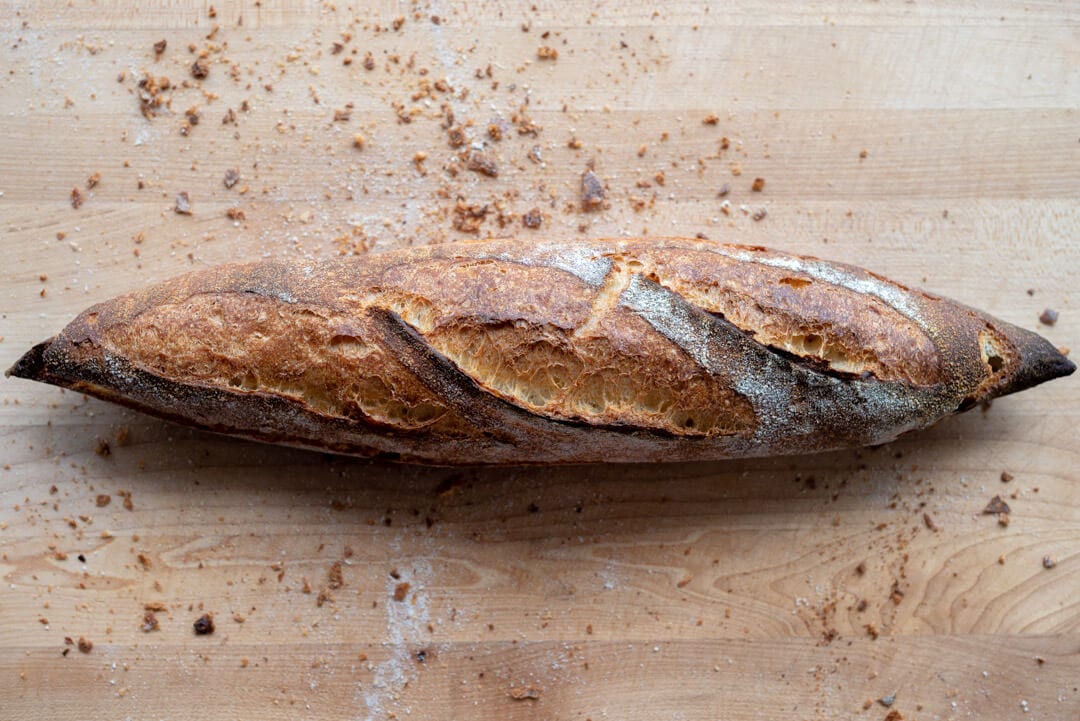The physical length of these baguettes will ultimately be determined by the size of your baking stone. When I make 300-gram baguettes on my Baking Steel, I roll them out to about 14″ in length. Because they're smaller than traditional baguettes, they're more like demi-baguettes. Regardless, shaping baguettes, whether smaller or larger, is almost the same with the only difference being their overall length.
Be sure to scroll to the bottom of this post to view a shaping video.
There are many ways to go about shaping baguettes, and each baker has their preference, but I’ve stuck to the method outlined by Jeffrey Hamelman in his seminal book, BREAD1. This approach imparts significant structure to the dough and helps keep the shape tight when proofing at room temperature before baking.
Shaping Process
There are five key steps when shaping baguettes in this way:
- Starting with a preshaped round (or rectangle), first fold the top half down to the middle and seal (upper left image, below)
- Flip the dough 180° and fold the new top down to the middle again, slightly overlapping the first fold (upper right image, below)
- Using your left-hand place your thumb horizontally with the middle seam and, using your fingers on the left hand, pick up and curl the top edge of the dough up and over your thumb. At each curl, use your right palm to seal this curl to the middle of the dough. Work your way from the right side of the dough to the left. Note that your right hand is only sealing the dough with the palm, it does nothing else (lower left image, below)
- Flip the dough 180° and repeat step 3 above, but this time seal the dough to the bottom firmly against the bench
- Using one hand, roll the dough away and toward your body in the middle, then transition to two hands and roll the dough back and forth as evenly as possible until the desired length is achieved. Note that during this rolling it's best to keep your fingertips and palms in contact with the bench at all times
The image below shows steps 1, 2, and 3. Starting in the upper left (1), upper right (2), lower left (3), and then lower right (dough resting before step 4). It's worth showing more detail on the sealing portion of this technique (steps 3 and 4). The images below show the second set of sealing, after the 4th image above, and the dough has been rotated 180°. Once you have sealed up the entire length, you can begin step 5: rolling out the cylinder to the desired length (for me, 14″ long). First, use one hand in the middle of the cylinder to start rolling and create the initial starting taper. You want it thicker in the middle and gradually taper to the end. Then, as you're rolling with one hand, gradually start rolling with two hands and continue back and forth to taper out the tube.
Be sure to keep your fingers and palms in contact with the bench as you roll back and forth. This helps create the consistent taper on each side of the tube.
Push and pull both your hands back and forth as you gently roll the dough out to your desired length. In the end, you'll have a tube that tapers consistently from the middle to the end. I prefer to make a sharp point at the ends.
Shaping Baguettes Video
Once rolled out, transfer with two hands to a liberally floured couche for their final proof on the counter.
What's next?
To learn other bread dough shapes, such as a round boule or oval bâtard, see my guide to shaping bread dough.
For a great starting recipe for naturally leavened baguettes, have a look at my sourdough baguette recipe! My Kamut demi-baguettes would also fit the bill if you'd like to try a baguette with freshly milled flour.
Either way, happy baking!
Additionally, I recently attended a week-long class taught by him in Washington where we all practiced this method.↩









